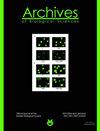Identification of two novel type II topoisomerase mutations in Enterococcus spp. isolated from a hospital in China
IF 0.8
4区 生物学
Q4 BIOLOGY
引用次数: 0
Abstract
Type II topoisomerases, including DNA gyrase (GyrA) and topoisomerase IV (ParC), contribute to fluoroquinolone resistance in Enterococcus spp. This study investigated the mutational status of the quinolone resistance-determining regions (QRDRs) of GyrA and ParC in the clinical isolates of enterococci from a hospital in Baotou, China. We analyzed 110 enterococcal isolates, including 57 Enterococcus faecalis and 53 Enterococcus faecalis faecium. The resistance rates of E. faecalis and E. faecium to ciprofloxacin were 63.16% and 84.91%, respectively. We found that 32 samples of E. faecalis and 42 of E. faecium had single or combined mutations in gyrA and/or parC, which were all resistant to ciprofloxacin. Only two ciprofloxacin-resistant E. faecalis isolates had no mutation. No mutations in gyrA and parC genes in all ciprofloxacinsusceptible isolates were found. Ciprofloxacin minimal inhibitory concentrations (MICs) in the mutation group were significantly higher than those of the non-mutation group, indicating that mutations in the QRDRs of gyrA and parC were correlated with MIC elevation. Two novel substitutions (GyrA Ser83Phe and ParC Ser80Leu) of E. faecalis were identified herein. Three-dimensional modeling revealed that these novel amino acid substitutions could disrupt the water/metal-ion bridge and decrease the interaction between the enzymes and ciprofloxacin. The data showed a diversity of mutation types in QRDRs of type II topoisomerases whose association with fluoroquinolone resistance in clinical isolates of enterococci warrants further investigation.中国某医院分离肠球菌两种新型II型拓扑异构酶突变的鉴定
II型拓扑异构酶,包括DNA回转酶(GyrA)和拓扑异构酶IV (ParC),参与肠球菌对氟喹诺酮类药物的耐药。本研究对包头某医院肠球菌临床分离株中GyrA和ParC的喹诺酮类耐药决定区(QRDRs)的突变情况进行了研究。我们分析了110株肠球菌,其中57株为粪肠球菌,53株为粪肠球菌。粪肠杆菌和粪肠杆菌对环丙沙星的耐药率分别为63.16%和84.91%。我们发现32份粪肠杆菌和42份粪肠杆菌存在gyrA和/或parC的单一或联合突变,这些突变均对环丙沙星具有耐药性。只有两株环丙沙星耐药粪肠球菌未发生突变。所有环丙沙星不敏感株gyrA和parC基因均未发现突变。突变组环丙沙星最小抑制浓度(MIC)显著高于非突变组,表明gyrA和parC QRDRs突变与MIC升高相关。本文发现了两个新的替换序列(GyrA Ser83Phe和ParC Ser80Leu)。三维模型显示,这些新的氨基酸取代可以破坏水/金属离子桥,降低酶与环丙沙星之间的相互作用。数据显示II型拓扑异构酶qrdr突变类型的多样性,其与肠球菌临床分离株氟喹诺酮类药物耐药性的关系值得进一步研究。
本文章由计算机程序翻译,如有差异,请以英文原文为准。
求助全文
约1分钟内获得全文
求助全文
来源期刊
CiteScore
1.40
自引率
0.00%
发文量
25
审稿时长
3-8 weeks
期刊介绍:
The Archives of Biological Sciences is a multidisciplinary journal that covers original research in a wide range of subjects in life science, including biology, ecology, human biology and biomedical research.
The Archives of Biological Sciences features articles in genetics, botany and zoology (including higher and lower terrestrial and aquatic plants and animals, prokaryote biology, algology, mycology, entomology, etc.); biological systematics; evolution; biochemistry, molecular and cell biology, including all aspects of normal cell functioning, from embryonic to differentiated tissues and in different pathological states; physiology, including chronobiology, thermal biology, cryobiology; radiobiology; neurobiology; immunology, including human immunology; human biology, including the biological basis of specific human pathologies and disease management.

 求助内容:
求助内容: 应助结果提醒方式:
应助结果提醒方式:


